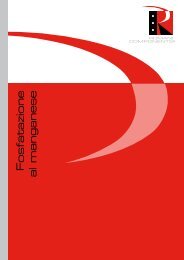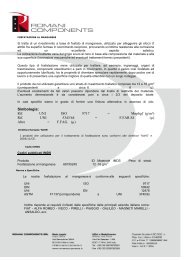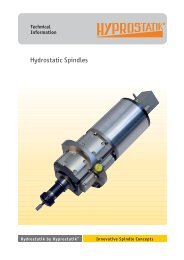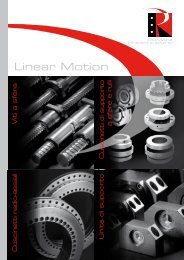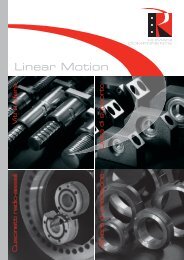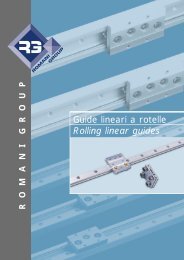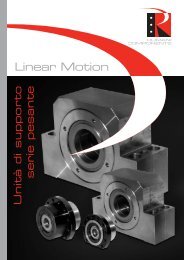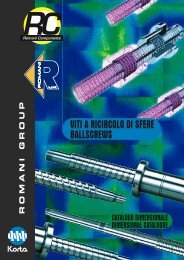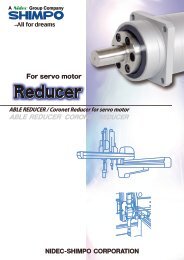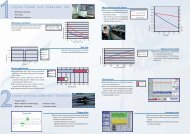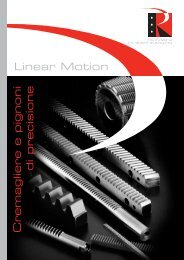catalogo tecnico technical catalogue - Romani Components
catalogo tecnico technical catalogue - Romani Components
catalogo tecnico technical catalogue - Romani Components
Create successful ePaper yourself
Turn your PDF publications into a flip-book with our unique Google optimized e-Paper software.
Deformación térmica del eje del husillo a bolas<br />
Thermal Deformation of Ball Screw Shaft<br />
La elongación axial resultante del<br />
aumento de temperatura ∆T (°C) viene dada<br />
por:<br />
The axial elongation resulting from an<br />
increase in temperature ∆T (°C) is given by:<br />
∆L = K a<br />
∆T L (mm)<br />
(52)<br />
K a = coeficiente de dilatación térmica (11,6 ·10 -6 / °C).<br />
Dicha dilatación debe de tenerse en<br />
cuenta cuando se seleccione la precarga y la<br />
compensación de paso con el objeto de obtener<br />
las condiciones óptimas de trabajo.<br />
K a = thermal expansion coefficient (11.6·10 -6 / °C).<br />
It is essential to consider thermal deformation<br />
when selecting the preload and the lead<br />
compensation, if optimum operating conditions<br />
are to be guaranteed.<br />
Torsión en el eje del husillo a bolas<br />
Torsion of the ball screw shaft<br />
La aplicación de un par al eje del husillo<br />
genera una deformación angular a torsión (θ),<br />
que se puede obtener de la siguiente fórmula:<br />
The torque applied to the ball screw<br />
shaft generates an angular torsion (θ) which is<br />
given as:<br />
θ = T E 102 L θ<br />
G l p<br />
(rad)<br />
(53)<br />
T E = par de torsión aplicado al husillo a bolas (Nm).<br />
G= módulo de elasticidad transversal del acero (8,1 10 4 N/mm 2 ).<br />
I p = momento de inercia polar de la sección del eje del husillo<br />
a bolas.<br />
T E = torque applied to the ball screw (Nm)<br />
G = steel modulus of crosswise elasticity (8.1*10 4 N/mm 2 ).<br />
I p = polar moment of inertia of the ball screw shaft crosssection.<br />
I p = 2 · I = π (d 2 ) 4 / 32 (mm 4 )<br />
I p = 2 · I = π (d 2 ) 4 / 32 (mm 4 )<br />
(54) (54)<br />
L θ = longitud de la parte del husillo sometido a la torsión (mm).<br />
L θ = length of the ball screw shaft subjected to twist (mm).<br />
El ángulo de torsión θ genera un retraso<br />
en el movimiento axial (∆l θ ):<br />
The angle of torsion θ produces axial<br />
lagging (∆l θ ):<br />
∆l θ = P h<br />
θ / 2π (mm)<br />
(55)<br />
Esta deformación normalmente es despreciable<br />
en comparación a la deformación producida<br />
por la carga axial (12)(ver apartado 1.1<br />
de la rigidez, página 37).<br />
This kind of deformation usually is negligible<br />
compared to the amount of deformation<br />
due to the axial load (12)(refer to paragraph 1.1<br />
under Rigidity, page 37).<br />
57



